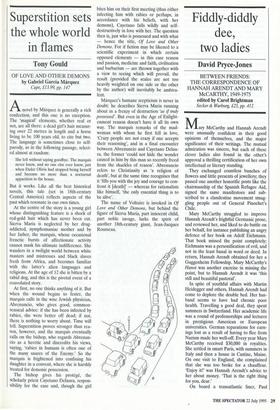Superstition sets the whole world in flames
Tony Gould
OF LOVE AND OTHER DEMONS by Gabriel Garcia Marquez
Cape, f13.99, pp. 147 novel by Marquez is generally a rich confection, and this one is no exception. The 'magical' elements, whether real or not, are all there: a dead girl's hair measur- ing over 22 metres in length and a horse living to be 100 years old, to cite but two. The language is sometimes close to self- parody, as in the following passage, select- ed almost at random:
She left without saying goodbye. The marquis never knew, and no one else ever knew, just when Dulce Olivia had stopped being herself and become no more than a nocturnal apparition in the house.
But it works. Like all the best historical novels, this tale (set in 18th-century Central America) reflects aspects of the past which resonate in our own times.
At the centre of the story is a young girl whose distinguishing feature is a shock of red-gold hair which has never been cut. Sierva Maria is neglected by her drug- addicted, nymphomaniac mother and by her father, the marquis, whose occasional frenetic bursts of affectionate activity cannot mask his ultimate indifference. She wanders in a twilight world between white masters and mistresses and black slaves fresh from Africa, and becomes familiar with the latter's alien languages and religions. At the age of 12 she is bitten by a rabid dog, and this is the pivotal event of a convoluted story.
At first, no one thinks anything of it. But when the wound begins to fester, the marquis calls in the wise Jewish physician, Abrenuncio, who gives good, common- sensical advice: if she has been infected by rabies, she were better off dead; if not, there is nothing to worry about. Time will tell. Superstition proves stronger than rea- son, however, and the marquis eventually calls on the bishop, who regards Abrenun- cio as a heretic and discredits his views, saying, 'rabies in humans is often one of the many snares of the Enemy.' So the marquis is frightened into confining his daughter in a convent, where she is harshly treated for demonic possession.
The bishop gives his protégé, the scholarly priest Cayetano Delaura, respon- sibility for the case and, though the girl bites him on their first meeting (thus either infecting him with rabies or perhaps, in accordance with his beliefs, with her demons), Cayetano falls wildly and self- destructively in love with her. The question then is, just who is possessed and with what — hence the title, Of Love and Other Demons. For if fiction may be likened to a scientific experiment in which certain opposed elements — in this case reason and passion, medicine and faith, civilisation and barbarism — are thrown together with a view to seeing which will prevail, the result (provided the scales are not too heavily weighted on one side or the other by the author) will inevitably be ambiva- lent.
Marquez's humane scepticism is never in doubt: he describes Sierva Maria running about in a frenzy of destruction 'as if truly possessed'. But even in the Age of Enlight- enment reason doesn't have it all its own way. The marquis remarks of the mad- woman with whom he first fell in love, 'Crazy people are not crazy if one accepts their reasoning', and in a final encounter between Abrenuncio and Cayetano Delau- ra, the former 'could not hide the wonder caused in him by this man so recently freed from the shackles of reason'. Abrenuncio refers to Christianity as 'a religion of death', but at the same time recognises that it 'fills you with the joy and courage to con- front it [death]' — whereas for rationalists like himself, 'the only essential thing is to be alive'.
The name of Voltaire is invoked in Of Love and Other Demons, but behind the figure of Sierva Maria, part innocent child, part noble savage, lurks the spirit of another 18th-century giant, Jean-Jacques Rousseau.


















































 Previous page
Previous page